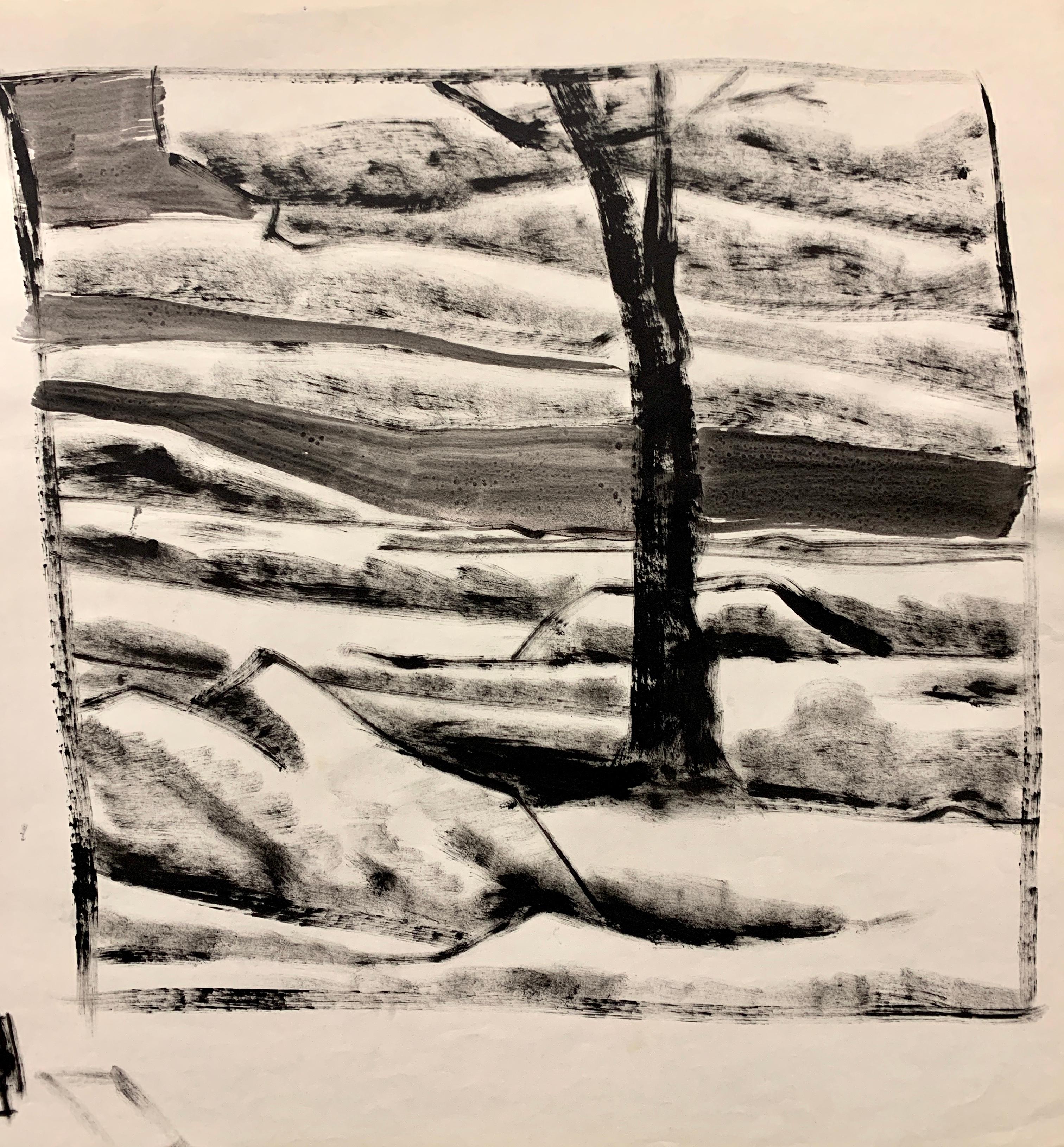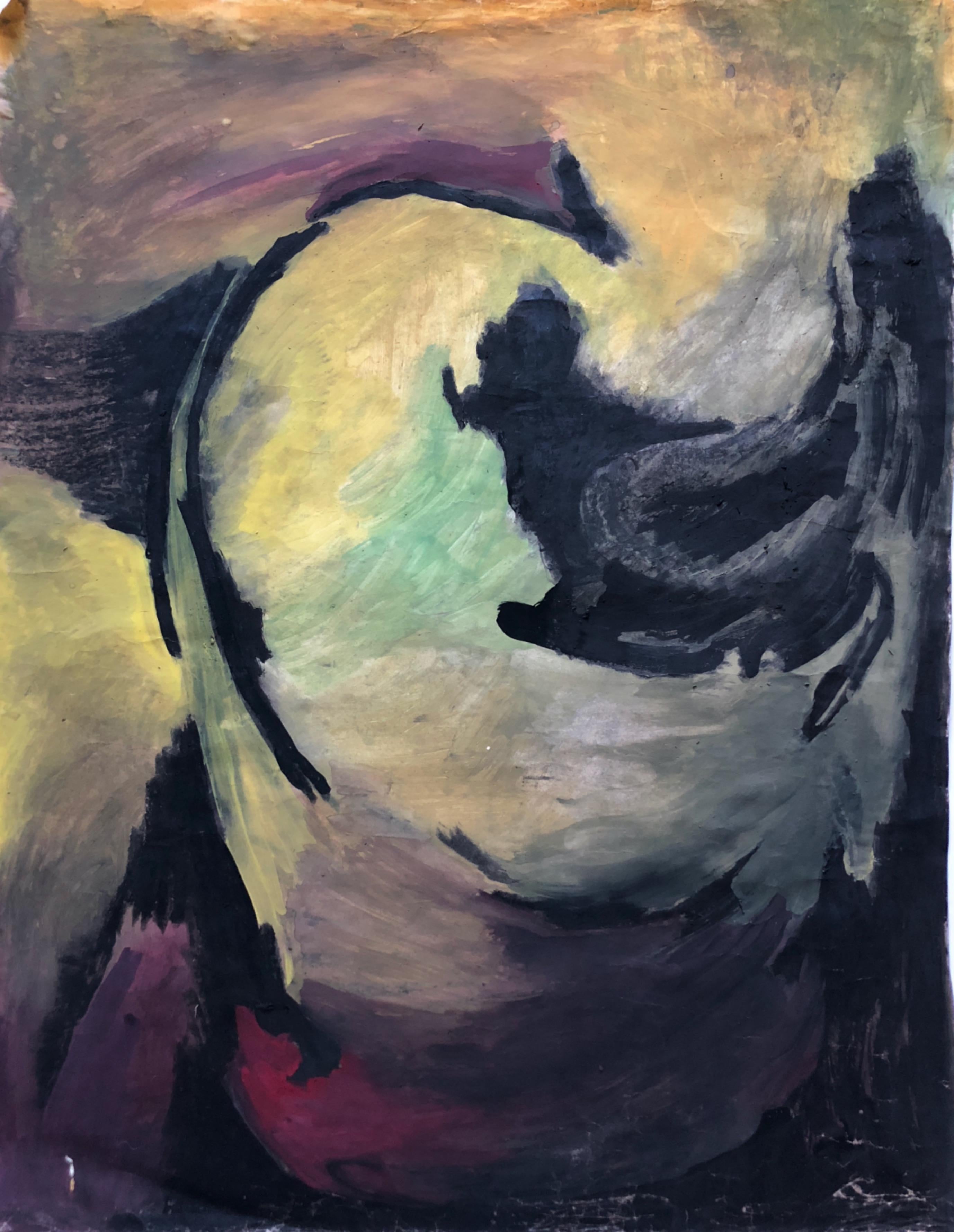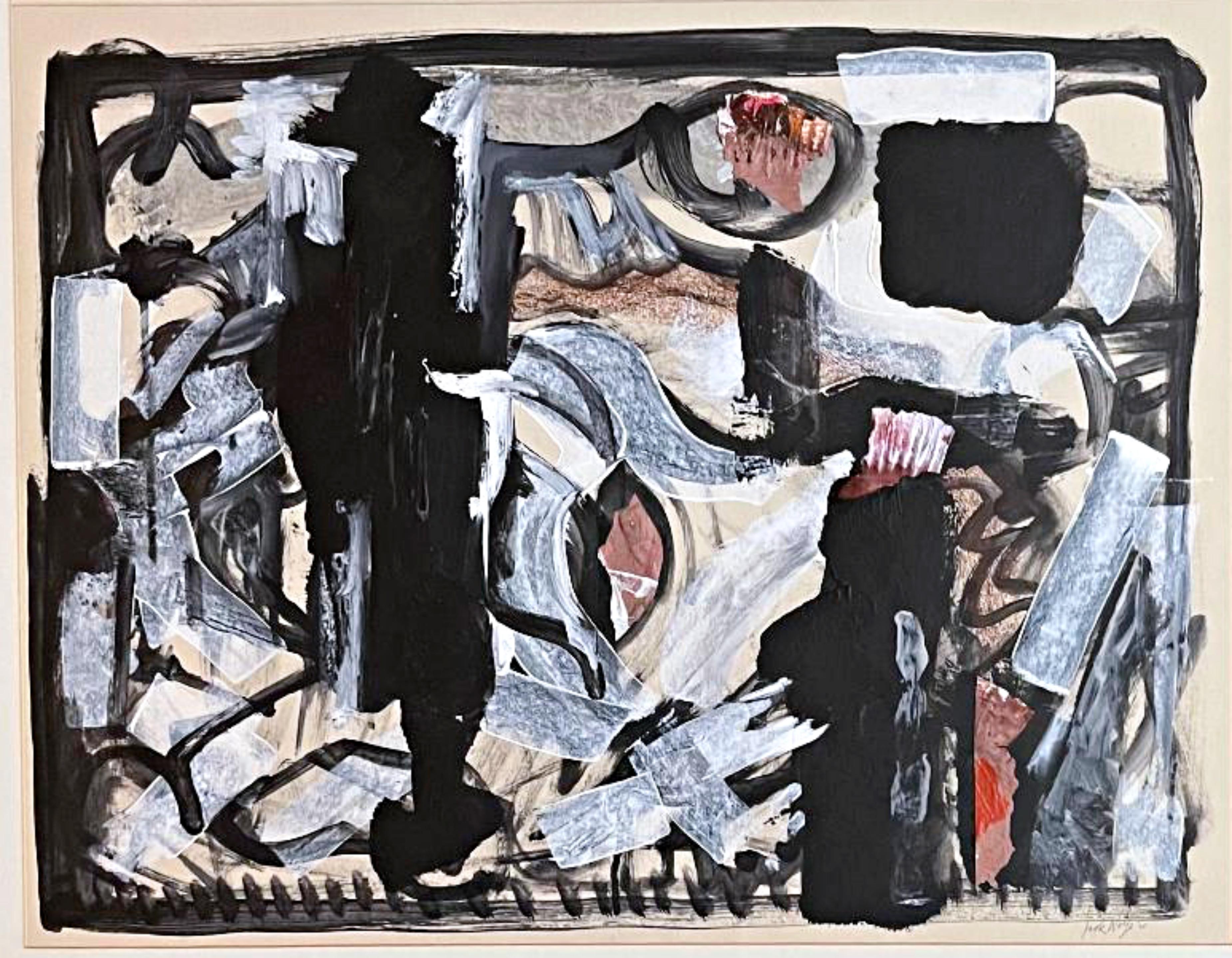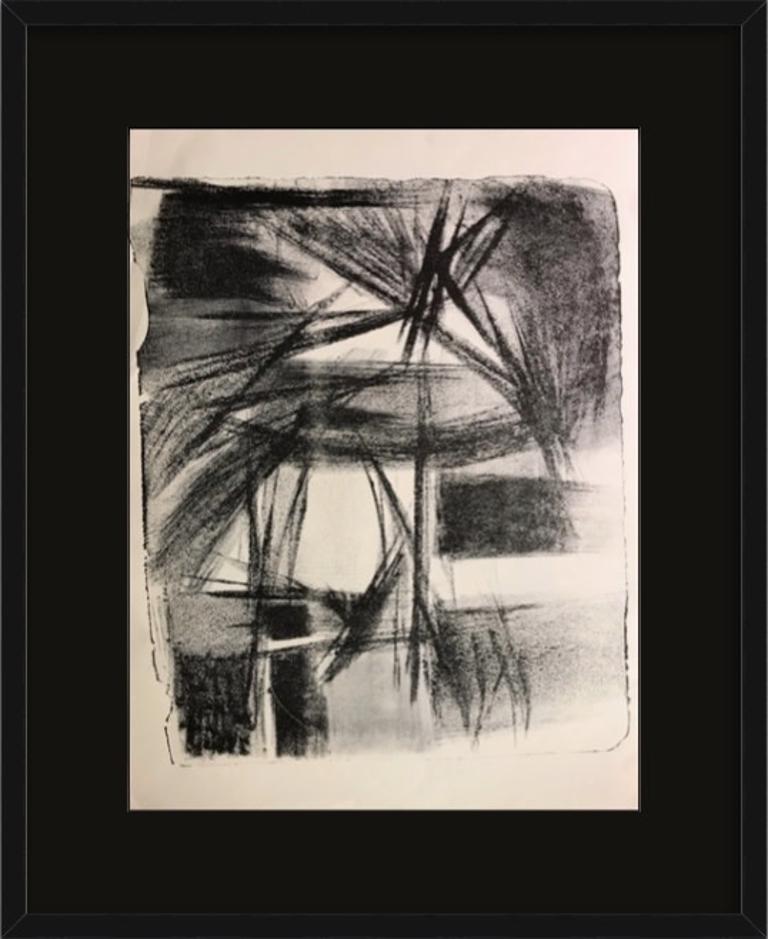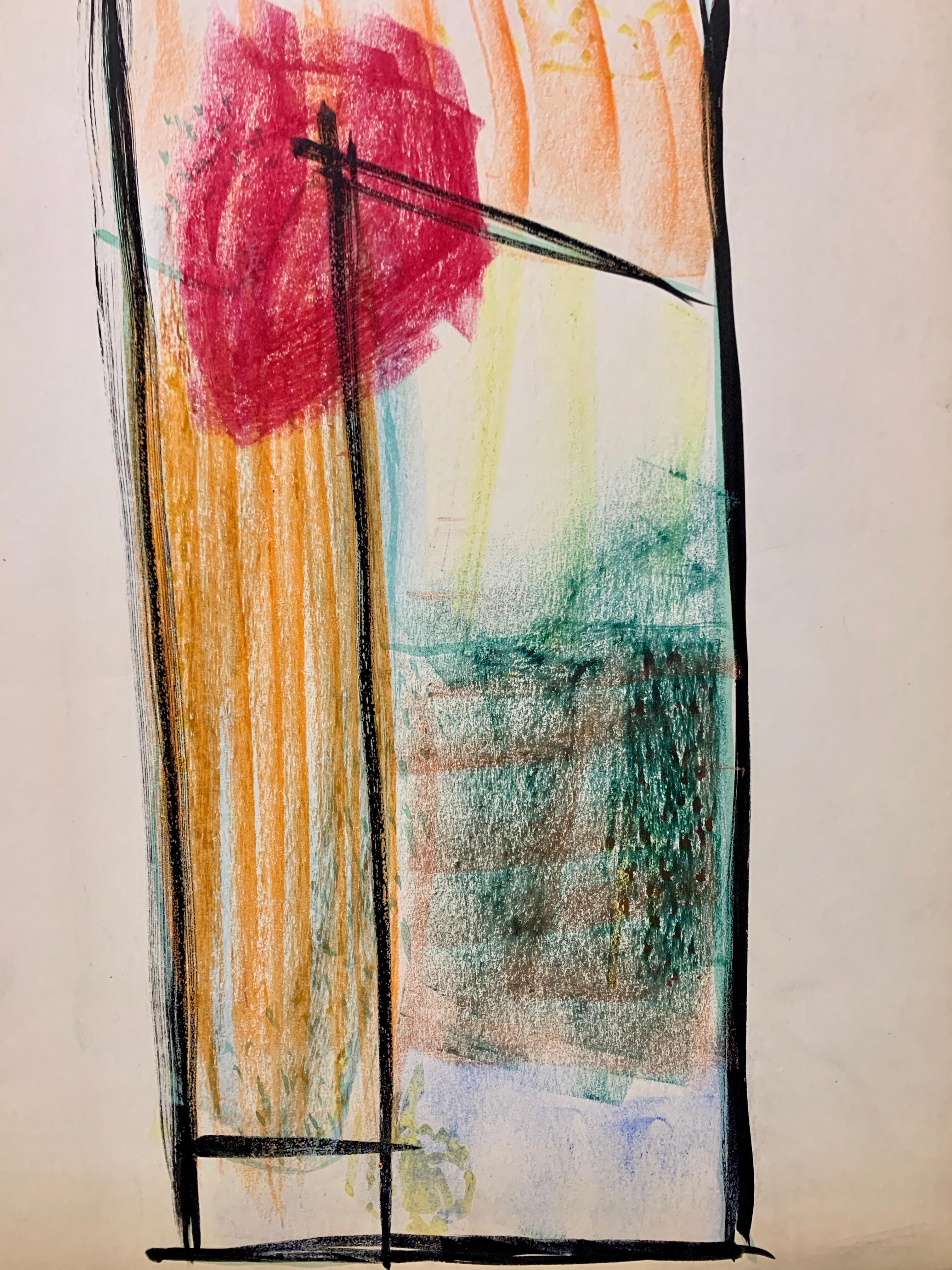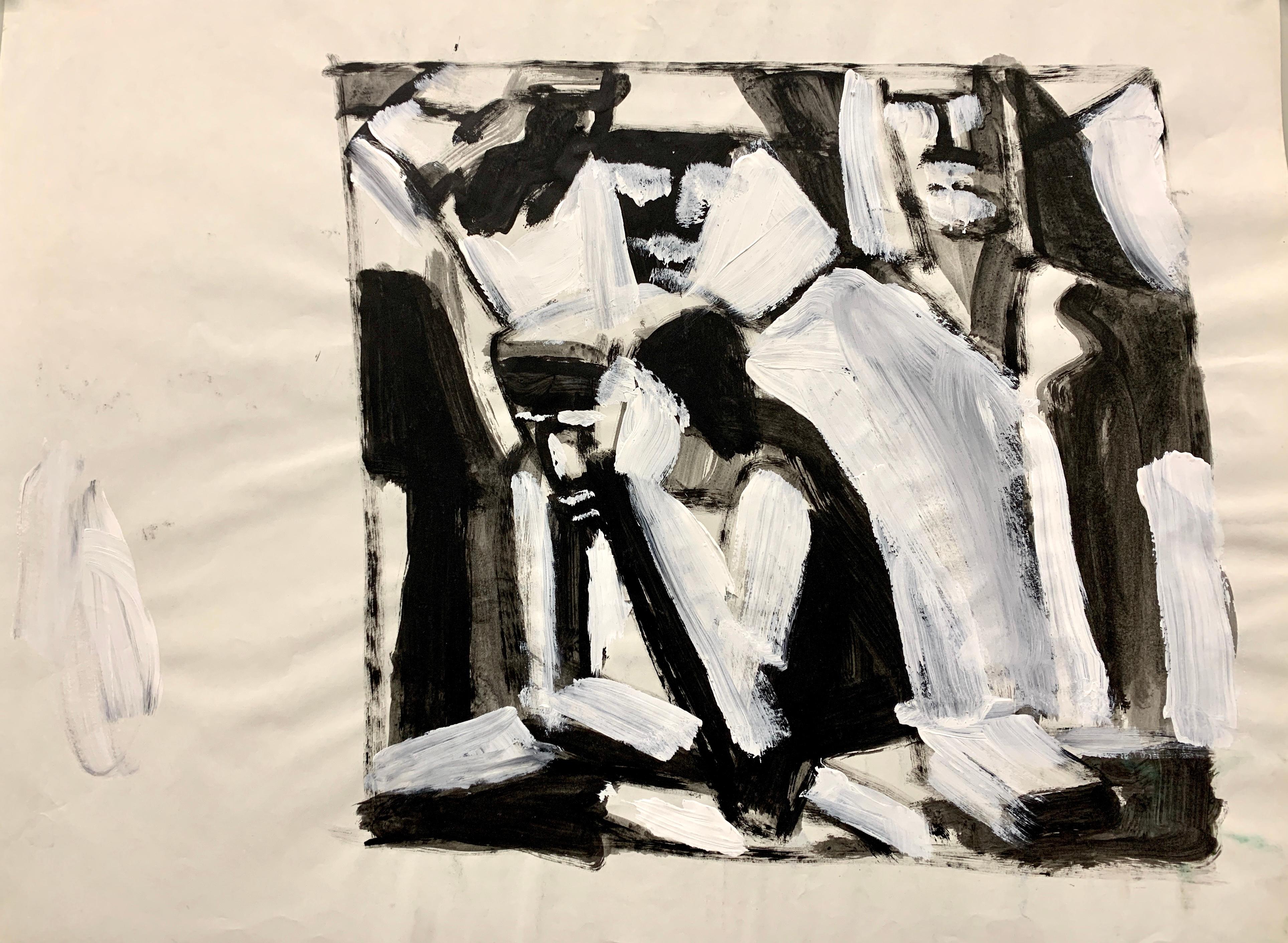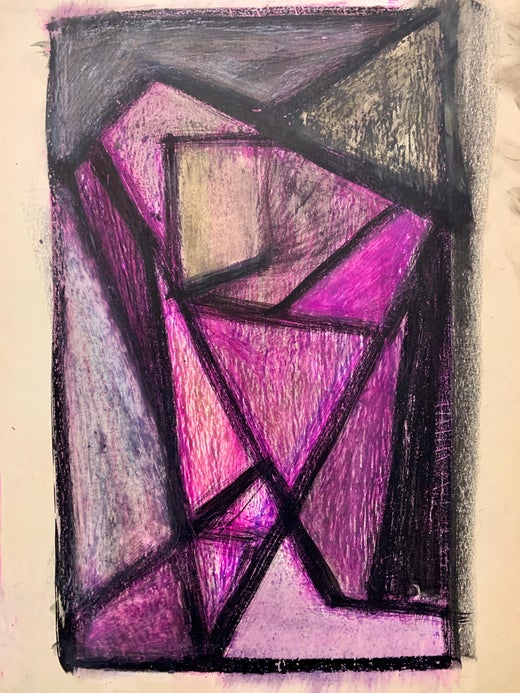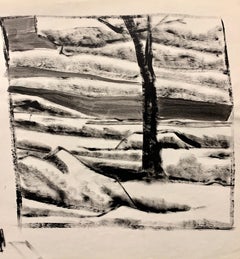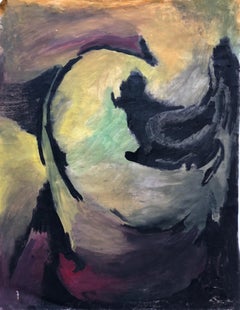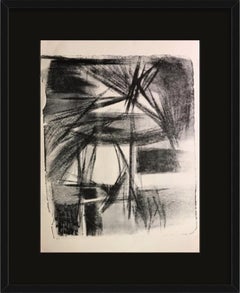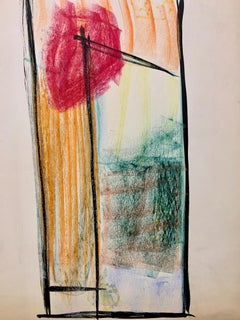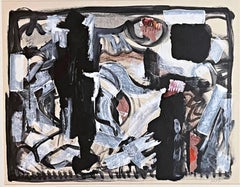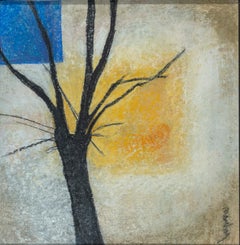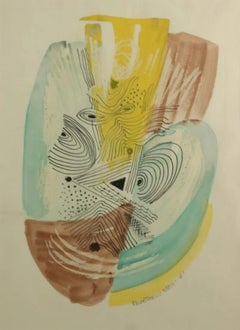Items Similar to 1950s "Mound Street" Mid Century Figurative Painting American Modernist
Video Loading
Want more images or videos?
Request additional images or videos from the seller
1 of 10
Donald Stacy1950s "Mound Street" Mid Century Figurative Painting American Modernistc. 1950s
c. 1950s
$570
$95040% Off
£428.59
£714.3240% Off
€497.70
€829.5040% Off
CA$795.99
CA$1,326.6540% Off
A$882.82
A$1,471.3640% Off
CHF 463.61
CHF 772.6940% Off
MX$10,841.60
MX$18,069.3340% Off
NOK 5,868.88
NOK 9,781.4640% Off
SEK 5,534.43
SEK 9,224.0540% Off
DKK 3,713.40
DKK 6,18940% Off
Shipping
Retrieving quote...The 1stDibs Promise:
Authenticity Guarantee,
Money-Back Guarantee,
24-Hour Cancellation
About the Item
Donald Stacy
"Mound Street"
c. 1950s
Gouache paint on paper
24" x 18'" unframed
Unsigned
Came from artist's estate
For sale is a striking black and white painting titled "Mound Street" by the renowned artist Donald Stacy (1925-2008) of New Jersey. Stacy studied at the Newark School of Fine Art, The Art Students League, Pratt Graphic Arts Center, and the University of Paris and Aix-en-Provence in the 1950s. He was also on the faculty of the Art Department of the New School, the Museum of Modern Art, School of Visual Arts, and had his own Stacy Studio Workshop.
This piece is a perfect example of Stacy's unique style, featuring a tree and boulders against a stylistic backdrop. The work is done in gouache paint on paper, and is unframed at a size of 24"x18". Although unsigned, it comes directly from the artist's estate and has been well-maintained, with only minor wear consistent with age and history. There is some wrinkling and toning present, but it does not detract from the overall beauty and impact of the painting.
Don't miss your chance to own a piece of art history by one of America's most talented artists. This painting would be an excellent addition to any collection.
Donald Stacy (1925-2011) New Jersey
Studied: Newark School of Fine Art
The Art Students League
Pratt Graphic Arts Center
University of Paris 1953-54
University of Aix-en-Provence 1954-55
Faculty: Art Department of the New School
Museum of Modern Art
School of Visual Arts
Stacy Studio Workshop
Exhibitions: Grand Central Moderns
George Wittenborn
The New School
Print Exhibitions, Chicago
University of Oklahoma
Honolulu Museum
Monclair Museum
Wisconsin State College
Louisiana Art Commission
Philadelphia Print Club
Kyoto Gallery
Grenchen, Switzerland
Documenta II Kassel, Germany
Alan Stone, Knoedlers
- Creator:Donald Stacy (1925 - 2011, American)
- Creation Year:c. 1950s
- Dimensions:Height: 18 in (45.72 cm)Width: 24 in (60.96 cm)
- Medium:
- Movement & Style:
- Period:
- Condition:Very Good Condition - Minor wear consistent with age and history. Wrinkling and toning.
- Gallery Location:Arp, TX
- Reference Number:1stDibs: LU153328292732
Donald Stacy
Donald Stacy (1925-2008) New Jersey Studied: Newark School of Fine Art
The Art Students League
Pratt Graphic Arts Center
University of Paris 1953-54
University of Aix-en-Provence 1954-55 Faculty: Art Department of the New School
Museum of Modern Art
School of Visual Arts
Stacy Studio Workshop Exhibitions: Grand Central Moderns
George Wittenborn
The New School
Print Exhibitions, Chicago
University of Oklahoma
Honolulu Museum
Monclair Museum
Wisconsin State College
Louisiana Art Commission
Philadelphia Print Club
Kyoto Gallery
Grenchen, Switzerland
Documenta II Kassel, Germany
Alan Stone, Knoedlers
About the Seller
5.0
Platinum Seller
Premium sellers with a 4.7+ rating and 24-hour response times
Established in 2015
1stDibs seller since 2021
101 sales on 1stDibs
Typical response time: 1 hour
Associations
Association of Women Art Dealers
- ShippingRetrieving quote...Shipping from: Tyler, TX
- Return Policy
Authenticity Guarantee
In the unlikely event there’s an issue with an item’s authenticity, contact us within 1 year for a full refund. DetailsMoney-Back Guarantee
If your item is not as described, is damaged in transit, or does not arrive, contact us within 7 days for a full refund. Details24-Hour Cancellation
You have a 24-hour grace period in which to reconsider your purchase, with no questions asked.Vetted Professional Sellers
Our world-class sellers must adhere to strict standards for service and quality, maintaining the integrity of our listings.Price-Match Guarantee
If you find that a seller listed the same item for a lower price elsewhere, we’ll match it.Trusted Global Delivery
Our best-in-class carrier network provides specialized shipping options worldwide, including custom delivery.More From This Seller
View All1950s "Landscape with Boulder" Donald Stacy Gouache Landscape Painting
By Donald Stacy
Located in Arp, TX
Donald Stacy
"Landscape wit Boulder"
c.1950s
Gouache paint on paper
24"x18'" unframed
Unsigned
Came from artist's estate
*Custom framing available for ad...
Category
Mid-20th Century Abstract Expressionist Landscape Paintings
Materials
Paper, Gouache
Mid Century Gouache and Oil Pastel Figurative Painting 1960s Bay Area Female Art
By Gloria Dudfield
Located in Arp, TX
Gloria Dudfield
Yellow Purple Figure
1960s
Oil Pastel and Gouache on Paper
36"x28" unframed $800
*Custom framing available for additional charge. Please ...
Category
Mid-20th Century Abstract Figurative Drawings and Watercolors
Materials
Paper, Oil Pastel, Gouache
C.1950s Abstract Mid Century Lithograph
By Jerry Opper
Located in Arp, TX
From the estate of Jerry and Ruth Opper
Abstract Fireworks
1950's
Stone Lithograph on Paper
12.5" x 19", Unframed
Came from a portfolio of his work from his estate.
Jerry Opper (192...
Category
Mid-20th Century Abstract Abstract Prints
Materials
Stone
1950s "Red Sun" Mid Century Abstract Art Students League NYC
By Donald Stacy
Located in Arp, TX
Donald Stacy
"Red Sun"
c.1950s
Gouache and oil pastel on paper
13.75" x 17" unframed
Unsigned
Came from artist's estate
*Custom framing available for additional charge. Please expect framing time between 3-5 weeks.
Donald Stacy (1925-2008) New Jersey
Studied: Newark School of Fine Art
The Art Students League...
Category
Mid-20th Century American Modern Abstract Drawings and Watercolors
Materials
Paper, Oil Pastel, Gouache
1950s "Group Meeting" Mid Century Figurative Gouache University of Paris
By Donald Stacy
Located in Arp, TX
Donald Stacy
"Group Meeting"
c.1950s
Gouache paint on paper
24" x 18'" unframed
Unsigned
Came from artist's estate
Donald Stacy (1925-2011) New Jersey
Studied: Newark School of Fin...
Category
Mid-20th Century American Modern Figurative Paintings
Materials
Paper, Gouache
1950s "Figure in Shadow" Figurative Gouache Painting America Modernist
By Donald Stacy
Located in Arp, TX
Donald Stacy
"Figure in Shadow"
c.1950s
Gouache paint on paper
24" x 18" unframed
Unsigned
Came from artist's estate
Donald Stacy (1925-2011) New Jersey
Studied: Newark School of Fine Art
The Art Students League
Pratt Graphic Arts Center
University of Paris 1953-54
University of Aix-en-Provence 1954-55
Faculty: Art Department of the New School
Museum of Modern Art
School of Visual Arts
Stacy Studio Workshop
Exhibitions: Grand Central Moderns
George Wittenborn
The New School
Print Exhibitions, Chicago
University of Oklahoma
Honolulu Museum
Monclair Museum
Wisconsin State College
Louisiana Art...
Category
Mid-20th Century American Modern Figurative Paintings
Materials
Paper, Gouache
You May Also Like
Mid century Modern 1960s Abstract Expressionist painting, renowned artist Signed
Located in New York, NY
Jack Wolfe
Untitled, 1965
Acrylic and collage on board
Hand signed on the front
Frame included: held in original vintage frame with original gallery label
Unique
Provenance: Parker Street 470 Gallery, Boston, Mass (with label verso)
Excellent abstract expressionist mixed media work.
Measurements:
Image:
17" x 24"
Framed:
24" x 28" x 1"
From Wiki:
Jack Wolfe (14 January 1924 – 18 November 2007) was a 20th-century American painter most known for his abstract art, portraiture, and political paintings. Jack Wolfe was born in Omaha, Nebraska on January 14, 1924, to Blanche and Everett L. Wolfe. Soon after his birth, his family moved to Brockton, MA. At 18, Wolfe had an interest in commercial illustration, which he pursued at the Rhode Island School of Design (RISD). However, upon matriculating at RISD in 1942, he developed an interest in fine art and painting inspired by an exhibition of modern French art. He described this change of direction, explaining that, "One day, for the first time, I saw an exhibition of modern French art. It was like being struck by lightning." He became particularly interested in the work of a number of European modernists, including Rouault, Cézanne, Braque, Modigliani, and Picasso.[1] Following his time at RISD, he pursued a Master’s in Fine Arts degree at the Museum of Fine Arts School in Boston, MA. At the Museum School, Wolfe studied under the renowned Expressionist Karl Zerbe, a German-born artist who was the Museum School's most influential and vital teacher until 1953.[2] After graduating from the Museum School, Wolfe was represented by the Margaret Brown Gallery in Boston, which also represented many other cutting edge Moderns that defied the more conservative tastes of New England collectors at the time, including György Kepes, Congur Metcalf, and Alexander Calder.[3]
Career and Museum Representation
Jack Wolfe's painting "Robin's Rock" 1962, 72" x 72"
Jack Wolfe's artwork received early recognition from a number of organizations and was consistently featured in influential exhibitions, including the 1955 Carnegie International at the Carnegie Institute in Pittsburgh, PA, the American Federation of Art's traveling exhibition New Talent in the USA in 1956-57, the Whitney Museum’s Young America exhibition in 1957,[4] the Boston Institute of Contemporary Art's Selection exhibition in 1957,[5] and both the Whitney Museum’s 1958 Annual exhibition and its Forty Artists Under Forty show in 1962-63.[6] In 1959, his widely acclaimed Portrait of Abraham Lincoln toured Europe in a show circulated by the Institute of Contemporary Art, Boston. In addition, his painting Crucifixion was chosen by the United States Information Agency to be exhibited across Europe, including being shown at the Salzburg Biennial in Austria in 1958.[7] Crucifixion was also exhibited at the Whitney Museum and subsequently displayed in the National Cathedral in Washington, DC, in 1958.[8] In 1966-67, his work was selected for Art for Embassies by the U.S. State Department.[9] He received the first annual Margaret Brown Memorial Award for high achievement by a New England Artist from the Institute of Contemporary Art, Boston, in 1958.[10]
With his future as one of the great artists of his time laid out neatly before him, Wolfe moved to New York in the early 1950s, which was then the postwar epicenter of the art world and in the midst of experiencing the first real revolution in American Art, now known as Abstract Expressionism.[11] However, almost immediately upon his arrival, he became disenfranchised with the overtly commercial nature of the art scene there, spurning fame and security in an unwillingness to bend his creative vision to the expectations of others.[12] After four short months, he left New York, returned to Massachusetts where he bought property in Stoughton, cleared the land, and built both his home and studio with his own two hands. He would go on to live and paint there, extensively exhibiting and garnering constant critical acclaim.[13]
Wolfe became one of the earliest artists championed by the deCordova Museum in Lincoln, MA and the Institute of Contemporary Art in Boston. He was awarded a traveling scholarship in 1958,[6] which allowed him to set up studio in San Miguel de Allende, Mexico and then in San Francisco, California.[14] Upon his return in 1959, the deCordova museum hosted Wolfe’s third solo exhibition, featuring work made during his time in California...
Category
1960s Abstract Expressionist Abstract Paintings
Materials
Mixed Media, Acrylic, Gouache, Permanent Marker
Early Mid Century Modern Abstract Painting
By Tommie Olson
Located in Houston, TX
Mid century modern abstract by artist Tommie (Thomas) Olson a student of Robert Preusser, when he was 16 and attending John Deagan High School in Houst...
Category
1960s Modern Abstract Paintings
Materials
Oil, Cardboard
Untitled
Located in Bournemouth, Dorset
Sally Barclay (1911-2000) was a New Jersey Artist known for her painting and activities as an art teacher.
Signed front and back.
Category
1950s American Modern Landscape Drawings and Watercolors
Materials
Crayon
$498 Sale Price
20% Off
Abstract American Modernism Mid-Century WPA Era Drawing Woodstock 20th Century
By Konrad Cramer
Located in New York, NY
Abstract American Modernism Mid-Century WPA Era Drawing Woodstock 20th Century, Sight size is 16 x 12 inches. The drawing is currently at the framers. A photo will be posted asap.
A...
Category
1930s Abstract Abstract Drawings and Watercolors
Materials
Paper, Ink, Watercolor
Mid Century Modern Abstract Painting by Don Clausen C.1959
By Don Clausen
Located in San Francisco, CA
Mid Century Modern Abstract Painting by Don Clausen C.1959
Early abstract by Clausen
Original oil on board
Dimensions 48" wide x 28.25" high
The frame measures 52" wide x 33.25" ...
Category
Mid-20th Century Abstract Abstract Paintings
Materials
Oil, Wood Panel
1960's Modern British Abstract Painting
Located in Cirencester, Gloucestershire
Stunning array of strong colors stand out in this original mid-20th century British abstract painting. The work dates to the 1950's-60's period and is of British authorship.
The pa...
Category
Mid-20th Century Abstract Abstract Paintings
Materials
Acrylic
